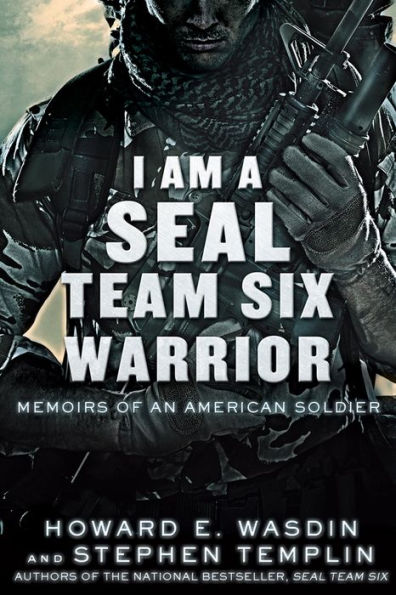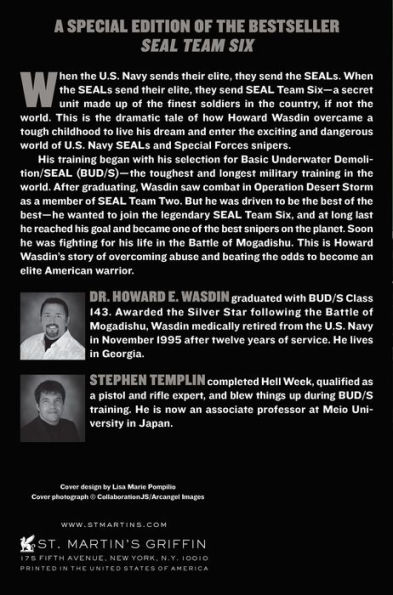Read an Excerpt
I Am a SEAL Team Six Warrior
Memoirs of an American Soldier
By Howard E. Wasdin St. Martin's Griffin
Copyright © 2012 Howard E. Wasdin
All right reserved. ISBN: 9781250016430
1.Reach Out and Touch Someone When the U.S. Navy sends their elite, they send the SEALs. When the SEALs send their elite, they send SEAL Team Six. It’s the navy’s equivalent to the army’s Delta Force. Its job is to fight terrorism and armed rebellion, often secretly.
I was a sniper for SEAL Team Six.
This is the first time a SEAL Team Six sniper’s story has been told. My story.
* * *
In the morning darkness of September 18, 1993, in Mogadishu, Somalia, another SEAL and I crept over a wall and up to the top of a six-story tower. Below us, people were waking up. Men, women, and children relieved themselves in the streets. I smelled the morning fires, fueled by dried animal dung. The fires heated the little food the Somalis had. The warlord who ruled this part of the city, Mohamed Farah Aidid, controlled the population by controlling the food supply. Every time I saw a starving child, I blamed Aidid.
Although the middle of a city may not seem the logical place for navy commandos, SEALs are trained to fight anywhere. That’s where the name comes from: SEa, Air and Land. On many operations, we were in all three: We’d parachute in, complete our task on land, and make our way back on water.
From the tower we watched what looked like a large garage with no roof. It was a vehicle body shop. Surrounding it was a city of despair. Somalis trudged along with their heads and shoulders lowered. Helplessness dimmed their faces, and starvation pulled the skin tight across their bones. This “better” part of town had multilevel, concrete buildings instead of the tin and wooden lean-to sheds that dominated most of the city and countryside. Nevertheless, the smell of human waste and death filled the air.
I played different scenarios over in my mind: one enemy popping out at one location, then another popping up at another location, and so on. I would acquire, aim, and even do a simulated trigger pull, going through my rehearsed breathing and follow-through routine while picturing the actual engagement. Then I simulated reloading and getting back into position looking through my scope, continuing to scan for more “booger-eaters”—the SEAL term for bad guys.
I had done this dry firing and actual firing thousands of times—wet, dry, muddy, snowbound, from a dug-in hole in the ground, from the window of a tall building, and nearly every which way imaginable. The words drilled into our heads since SEAL training were, “The more you sweat in peacetime, the less you bleed in war.” This particular day, I was charged with making sure none of my Delta Force buddies sprang a leak as I covered their insertion into the garage. That was every bit as important as my not bleeding.
Our target for this mission was Osman Ali Atto—warlord Aidid’s main financier. Atto and his boss had killed hundreds of thousands of Somalis. I felt that if we could kill Atto and Aidid, we could stop the fighting, get the food to the people quickly, and go home in one piece. But the goal of this mission was just to capture Atto, not kill him.
Around 0815 our “asset”—our informer—gave the predetermined signal that Atto was there. My SEAL teammate and I launched the “full package.” Little Bird and Black Hawk helicopters filled the sky.
Delta Force operators fast-roped into the roofless garage, dropping lines from the helicopter and sliding right to the ground. Rangers fast-roped around the outside of it. Little Birds flew overhead with Delta snipers to protect the assault force.
Atto’s people scattered like rats. Enemy militia shot at the helicopters.
In this environment, an enemy could appear from anywhere, dressed the same as a civilian. Even if he appeared with a gun, there was a chance he was part of a clan on our side. We had to wait until the person pointed the weapon at us. Then we would ensure the enemy ceased to exist. There was no time for makeup or second shots.
Like my SEAL teammate—his nickname was Casanova—I wielded .300 Win Mag sniper rifle. Through my scope, I saw a militiaman 500 yards away firing through an open window at the helos. I made a mental note to keep my heart rate down and centered the crosshairs on him as my muscle memory took over—stock firmly into the shoulder, cheek positioned behind the scope, eye focused on the center of the crosshairs rather than the enemy, and steady trigger squeezing. I felt the gratifying recoil of my rifle. The round hit him in the side of the chest. He convulsed and buckled, falling backward into the building—permanently.
I quickly got back into my scope and scanned my sector.
Game on now. All other thoughts departed my mind. Casanova scanned his sector, too.
Another Aidid militiaman carrying an AK-47 came out a fire escape door on the side of a building 300 yards away from me and aimed his rifle at the Delta operators assaulting the garage. From his position, I’m sure he thought he was safe from the assaulters, and he probably was. He was not safe from me—300 yards wasn’t even a challenge. I shot him through his left side, and the round exited his right. He slumped down onto the fire escape landing, never knowing what hit him. His AK-47 lay silent next to him. Someone tried to reach out and retrieve the weapon. One round from my Win Mag put a stop to that.
Each time I made a shot, I immediately forgot about that target and scanned for another.
Chaos erupted inside and outside of the garage. People ran everywhere. Little Birds and Black Hawks filled the skies with deafening rotor blasts. I was in my own little world, though. Nothing existed outside my scope and my mission. Let the Unit guys handle their business in the garage. My business was reaching out and touching the enemy.
A few minutes passed as I continued scanning. More than 800 yards away, a guy popped up with an RPG launcher on his shoulder, preparing to fire at the helicopters.
If I took him out, it would be the longest killing shot of my career. If I failed …
Copyright © 2012 by Howard E. Wasdin and Stephen Templin
Continues...
Excerpted from I Am a SEAL Team Six Warrior by Howard E. Wasdin Copyright © 2012 by Howard E. Wasdin. Excerpted by permission.
All rights reserved. No part of this excerpt may be reproduced or reprinted without permission in writing from the publisher.
Excerpts are provided by Dial-A-Book Inc. solely for the personal use of visitors to this web site.






